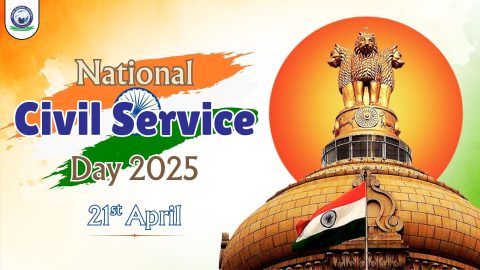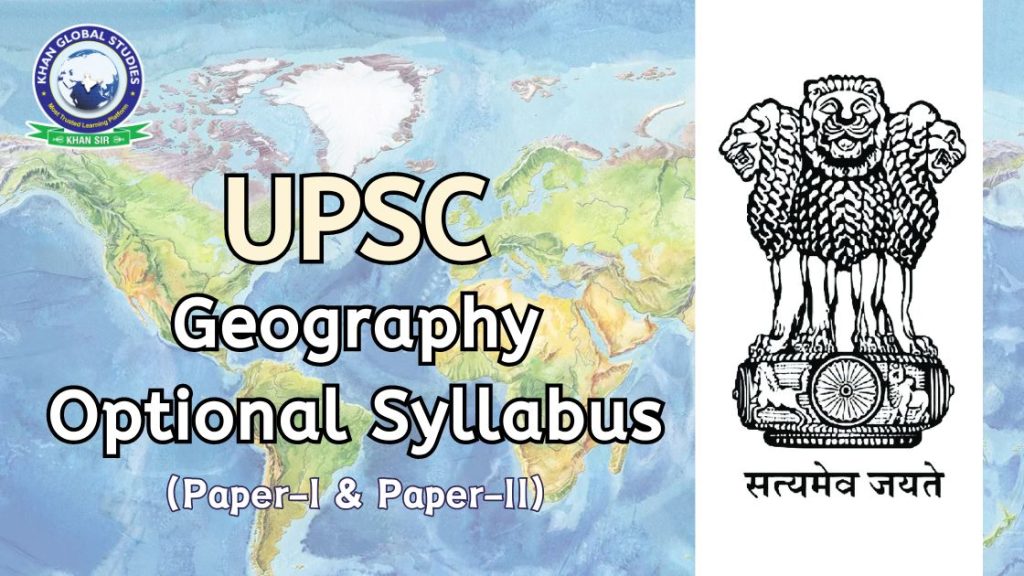Geography is one of the optional subjects in the UPSC CSE Mains exam. It is also included in the General Studies paper in Prelims and GS Paper 1 in UPSC CSE Mains. UPSC Geography Optional consists of two papers, Paper 1 and Paper 2, each of 250 marks. UPSC Paper 1 Geography syllabus covers the principles of geography, and Paper 2 covers the geography of India. This article covers the UPSC Geography optional syllabus for both Paper 1 and Paper 2, some tips on how to prepare for this subject and the essential topics of the subject.
UPSC Prelims Geography Syllabus
| Indian Geography | Basic of India Physical Features River Systems Climate Minerals and Industries Agriculture Natural Vegetarian and Fauna Economic Infrastructure Human Geography |
| World Geography | Major Natural regions Regional Geography of Developed Countries Regional Geography of South Asia |
| Physical Geography | Geomorphology Climatology Oceanography Biogeography |
| Human Geography | Man & Environment Growth & Development Population, Tribes, Migration Economic Activities Settlements, Urbanisation, Functional Classification of Towns |
What is the UPSC Geography Optional Syllabus?
UPSC Geography is one of the most popular optional subjects among the applicants. Geography as an optional subject for UPSC has consistently given excellent results in the Civil Services Examination. For a variety of reasons, this theme is an excellent choice as an alternative. It is a subject that is both scientific and humanistic, varied, complex and subtle. As a result, it is an excellent choice for engineers, doctors and candidates with arts backgrounds. Out of a total of 1750 marks for all main papers, the weightage of optional paper is 500 marks, i.e. 250 marks for each paper. This can be useful for the candidates as it overlaps with GS Paper 1 and is sometimes useful for the essay paper.
UPSC Geography Optional Syllabus – Paper 1
Principles of Geography
Physical Geography:
- Geomorphology: Factors controlling landform development; Endogenous and exogenous forces; Origin and evolution of the Earth’s crust; Fundamentals of geomagnetism; The physical conditions of the Earth’s interior; geosynclines; Continental drift; Homeostasis; plate tectonics; Recent Thoughts on Mountain Formation; Volcano; earthquakes and tsunamis; Concepts of geomorphic cycles and landscape evolution; denudation chronology; Channel Morphology; corrosion surfaces; slope development; Applied Geomorphology; Geomorphology, Economic Geology and Environment.
- Climatology: Temperature and pressure belts of the world; Earth’s heat budget; atmospheric circulation; Atmospheric stability and instability. planetary and local winds; Monsoon and jet stream; Air masses and fronts; temperate and tropical cyclones; Types and distribution of rainfall; weather and climate; Köppen’s classification of world climates by Thornthwaite and Trevor Thye; hydrological cycle; Global climate change, and the role and response of humans in climate change, applied climatology and urban climate.
- Oceanography: bottom topography of the Atlantic, Indian and Pacific oceans; temperature and salinity of the oceans; heat and salt budget, ocean deposits; Waves, currents and tides; Marine Resources; biological, mineral and energy resources; Coral reefs coral bleaching; sea-level changes; Law of the sea and marine pollution.
- Biography: Origin of Soil; Classification and distribution of soils; Types of soil; Soil erosion, degradation and conservation; Factors affecting the world distribution of plants and animals; Deforestation problems and conservation measures; Social Forestry, Agroforestry; the wildlife; Major gene pool center.
- Environmental Geography: Principles Ecology; Human ecological adaptation; Human impact on ecology and environment; Global and regional ecological changes and imbalances; Ecosystems, their management and conservation; Environmental degradation, management and conservation; Biodiversity and Sustainable Development; Environmental policy; Environmental hazards and remedial measures; Environmental education and law.
Human Geography:
- Perspectives in Human Geography: Regional Differentiation; regional synthesis; Dualism and Dualism; environmentalism; The quantitative revolution and spatial analysis; Radical, pragmatic, humanitarian and welfare approaches; Languages, Religion and Secularism; Cultural regions of the world; Human Development Index.
- Economic Geography: World Economic Development: Measurement and Problems; World resources and their distribution; Energy Crisis; Limits to Development; World Agriculture: Types of Agricultural Regions; Agricultural Inputs and Productivity; Food and Nutrition Issues; Food Security; Famine: Causes, Effects and Remedies; World Industries: Location Patterns and Problems; Patterns of world trade.
- Population and Settlement Geography: Growth and distribution of world population; demographic characteristics; Causes and consequences of migration; Concepts of maximum and optimal population; Population theory, world population problems and policies, social welfare and quality of life; Population as social capital. Types and patterns of rural settlements; Environmental issues in rural settlements; Hierarchy of urban settlements; Urban Morphology; The concept of the primate city and the rank-size rule; Functional classification of towns; Urban area of influence; Rural-urban boundary; Satellite cities; Problems and solutions of urbanization; Sustainable development of cities.
- Regional Planning: Concept of a region; Types of regions and methods of regionalization; Growth center and growth pole; Regional imbalance; Regional development strategies; Environmental issues in regional planning; Planning for sustainable development.
- Models, Theories and Laws in Human Geography: Systems Analysis in Human Geography; Malthusian, Marxist and demographic transition models; Kristeller and Lausch’s central place theory; Perroux and Baudville; Von Thünen’s model of the agricultural sector; Weber model of industrial location; Ostov’s model of stages of development. Heartland and rimland theory; International borders and the law of limitations.
UPSC Geography Optional Syllabus – Paper 2
Geography of India
- Physical Setting: India’s space relations with neighbouring countries; Structure and relief; Drainage systems and watersheds; geographic region; Mechanism and rainfall patterns of the Indian monsoon; tropical cyclones and western disturbances; floods and droughts; climate zone; Natural vegetation, soil types and their distribution.
- Resources: land, surface and groundwater, energy, minerals, biological and marine resources, forest and wildlife resources and their conservation; energy crisis.
- Agriculture: Infrastructure: irrigation, seeds, fertilizers, power; Institutional factors; Landholdings, land ownership and land reform; Cropping patterns, agricultural productivity, agricultural intensity, cropping combinations, land capacity; Agriculture and Social Forestry; Green Revolution and its socio-economic and ecological implications; Importance of dry farming; Livestock Resources and the White Revolution; Aqua-culture; Sericulture, agriculture and poultry farming; agricultural regionalization; Agro-climatic zones; Agro-ecological zone.
- Industry: Development of industries; Local factors of cotton, jute, textiles, iron and steel, aluminium, fertilizers, paper, chemicals and pharmaceuticals, automobiles, cottage and agro-based industries; Industrial houses and premises including public sector undertakings; industrial regionalization; New Industrial Policy; Multinational Companies and Liberalization; Special Economic Zone; Tourism including ecotourism.
- Transport, communications and trade: road, railway, waterway, airway and pipeline networks and their complementary roles in regional development; The increasing importance of ports on national and foreign trade; balance of trade; trade policy; Export Processing Zones; Developments in communication and information technologies and their effects on the economy and society; Indian space programme.
- Cultural Environment: Historical Perspective of Indian Society; Racial linguistic and ethnic diversities; religious minorities; Major tribes, tribal areas and their problems; cultural sector; Population growth, distribution and density; Demographic characteristics: sex-ratio, age structure, literacy rate, work-force, dependency ratio, longevity; Migration (intra-regional, intra-regional and international) and related problems; Population Problems and Policies; Health indicators.
- Settlements: Types, patterns and morphology of rural settlements; Urban Development; Morphology of Indian Cities; Functional Classification of Indian Cities; Suburbs and metropolitan areas; Urban Sprawl; Slums and their associated problems; town planning; Problems and Solutions of Urbanization.
- Regional Development and Planning: Experience of Regional Planning in India; Five Year Plans; Integrated Rural Development Programme; Panchayati Raj and Decentralized Planning; Command Area Development; watershed management; Planning for the development of backward areas, desert, drought-prone, hilly tribal areas; multi-level planning; Regional planning and development of island areas.
- Political Aspects: Geographical basis of Indian federalism; state reorganisation; Emergence of new states; Regional consciousness and interstate issues; India’s international boundary and related issues; cross-border terrorism; India’s role in world affairs; Geopolitics of South Asia and the Indian Ocean Region.
- Contemporary Issues: Ecological Issues: Environmental Hazards: Landslides, earthquakes, tsunamis, floods and droughts, epidemics; Issues related to environmental pollution; changes in land use patterns; Principles of environmental impact assessment and environmental management; Population explosion and food security; environmental degradation; deforestation, desertification and soil erosion; problems of agriculture and industrial unrest; regional disparities in economic development; Concept of sustainable growth and development; environmental awareness; Linkage of rivers; Globalization and Indian Economy.
How to prepare for the UPSC Geography syllabus?
- Reading: Start reading Geography NCERT as it is easy and simple to understand and clear the concepts. This will create a strong base. It is important to focus on the fundamentals of geography, such as physical and human geography.
- Previous Year Question Papers: It should be studied. Solving previous year’s questions helps in identifying and analyzing the important topics that need to be revised thoroughly.
- Answer Writing: Start writing answers after finishing one or two units. Explain basic concepts. Analyze PYQ with related topics. One can refer to Topper’s answers for structure and presentation. Try to include more dimensions in the answer, such as physical and human dimensions. Make sure that the written answers are as per the syllabus. Answer: It is necessary to combine Paper 1 and Paper 2 for enrichment. Writing answers regularly is the key to scoring more marks. One can also make use of case studies and data wherever possible.
- Mapping and Diagrams: Preparation for the Geography syllabus for UPSC is incomplete without mapping. Mapping and relevant diagrams help in scoring more marks than the average answer. Attempts should be made to include maps or diagrams in answers. This requires practice; Adding maps and diagrams is not easy without practice. Prepare area-wise and subject-wise maps.
- Current Affairs: Current affairs related to Geography is an important aspect while preparing for the Static part. Nowadays, it has become a trend to combine static segments with current affairs.


